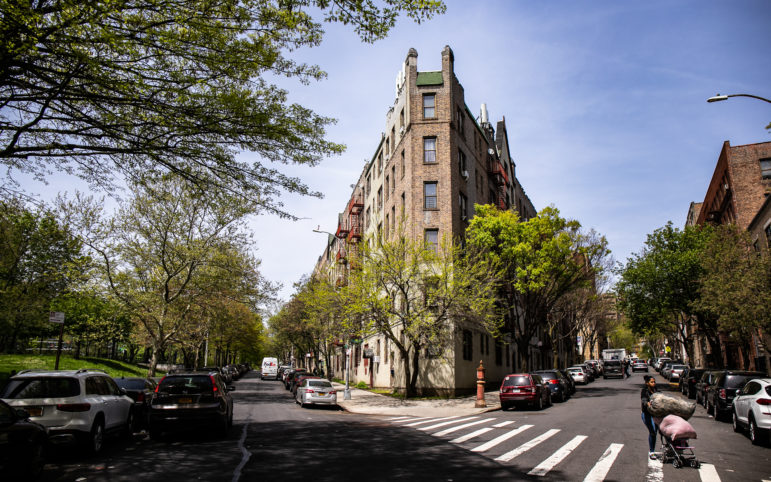The number of available apartments for low- and middle- income New Yorkers reached a 30-year low in 2021, according to the results of a vacancy survey used to determine whether rent stabilization laws will remain in place in the five boroughs.

Adi Talwar
Apartments on East Mosholu Parkway North and Steuben Avenue in The Bronx.The number of available apartments for low- and middle- income New Yorkers reached a 30-year low in 2021, according to the results of a vacancy survey used to determine whether rent stabilization laws will remain in place in the five boroughs.
Less than 1 percent of all apartments priced below $1,500 per month sit empty, an “extreme vacancy shortage” and the lowest rate since 1991, the most recent Housing and Vacancy Survey (HVS) shows. Citywide, about 4.5 percent of New York City’s roughly 2.3 million apartments were vacant and available for rent last year, up from 3.63 percent the last time the survey was conducted in 2017. Under state law, a vacancy rate below 5 percent allows New York City to declare a “housing emergency” and triggers the continuation of rent-stabilization for more than 1 million apartments citywide. The vacancy rate has never surpassed 5 percent since the survey began in 1965.
The city’s Department of Housing Preservation and Development (HPD) released the initial findings of the HVS on Tuesday, after state lawmakers voted twice to delay the report by more than a year due to the COVID-19 pandemic and to accommodate U.S. Census outreach.
The survey, conducted by the federal Census Bureau between February and mid-July 2021, presents a sweeping review of New York City’s housing stock, median rents and individual borough vacancy rates that reflect the city’s affordable housing crunch. In Manhattan, more than 10 percent of apartments sat vacant. In the Bronx, the vacancy rate was less than 1 percent. In Queens and Staten Island, the vacancy rate was 4.15 percent. It was 2.73 percent in Brooklyn.
The median monthly asking rent on vacant apartments was $2,750 during the survey period, meaning household income would need to top $110,000 for a tenant to pay less than 30 percent of their earnings on rent, the threshold at which a tenant is considered “rent-burdened.” More than half of New York City renter households met that threshold last year, the report found. At least 13 percent of tenants reported missing at least one rent payment.
The findings also mean that the median household income for renters—$50,000, according to the survey—would have to more than double to keep up with median asking rent.
The survey shed light on the true extent of New York City's affordable housing crisis, with units at the lowest end of the market—places priced below $900 per month—the hardest to come by. Just 0.86 percent of those apartments were vacant and available for rent. Meanwhile, only 0.93 percent of apartments priced between $900 and $1499 were vacant.
At the other end of the spectrum, 12.64 percent of units priced above $2,300 were vacant and available for rent; just over 4 percent of apartments priced between $1,500 and $2,299 were empty, the survey found.
The vacancy rate disparities reflect the dwindling supply of affordable housing citywide. Between 2017 and 2021, New York City lost about 96,000 units priced below $1,500 per month while adding about 107,000 units renting for $2,300 or more, the survey found. That dramatic loss of affordable housing continues a 30-year trend across the five boroughs. New York City has lost about 500,000 apartments priced below $1,500 since 1991 while adding about 500,000 priced at $2,300 or more.
“The findings are clear: Our city’s affordable housing crisis is as dire as ever, and that’s why I am working every day to create and preserve the high-quality, affordable housing hard-working New Yorkers need and deserve,” said Mayor Eric Adams in a statement accompanying the report.
Adams has called for rent increases on New York City’s more than 1 million stabilized apartments, citing the impact of the pandemic and inflation on property owners.
Adams and other members of his administration used the report to tout the need to dramatically increase housing production to keep up with demand.
New York City housing production trails population growth by a wide margin, but another factor is also driving rising rents and limited supply: more than 353,400 units remain vacant but are not available for rent—up from 248,000 in 2017—the HVS found. Nearly 103,000 of those units are second homes, or pied-a-terres, according to the survey, a finding that could renew calls for a “pied-a-terre tax” on empty units used seasonally or sparingly.
The survey was the first conducted since the catastrophic impact of the COVID pandemic, which has killed tens of thousands of New Yorkers and fueled economic and employment crises. The pandemic also affected the data collection and timing of the report, which is scheduled by law to come out every three years. New York State lawmakers first voted to prolong its release to accommodate 2020 U.S. Census data collection—the U.S. Census Bureau administers the HVS—and again due to COVID-19.
But skeptical landlord groups have said political considerations were the true cause of the delay: the exodus of wealthy New Yorkers in the early days of the COVID crisis threatened to lift the vacancy rate above 5 percent and threaten rent stabilization, those critics say.
New York City’s rental market has since rebounded, with asking rents surging at every price level—further straining tenant resources—and bidding wars now the norm.
The report, said New York City’s Chief Housing Officer Jessica Katz, illustrates the “staggering level of rent burden, supply shortage and housing quality issues that we must address to give all New Yorkers the safe, quality and affordable homes they deserve.”
READ MORE:








